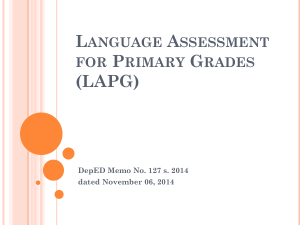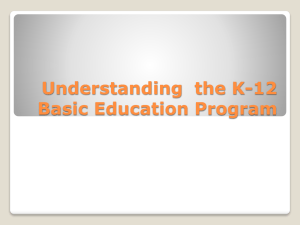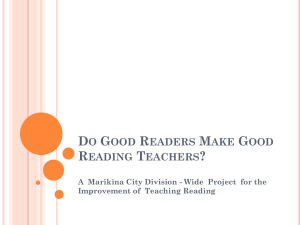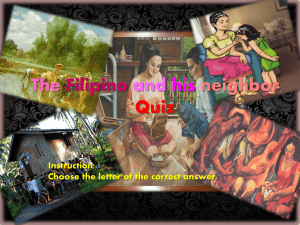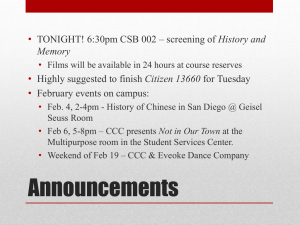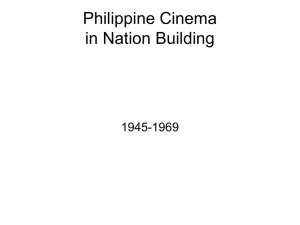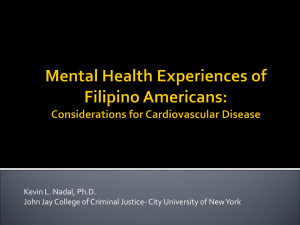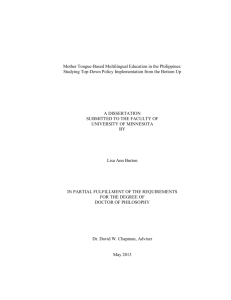MTB-MLE: Mother Tongue-Based Multilingual Education
advertisement
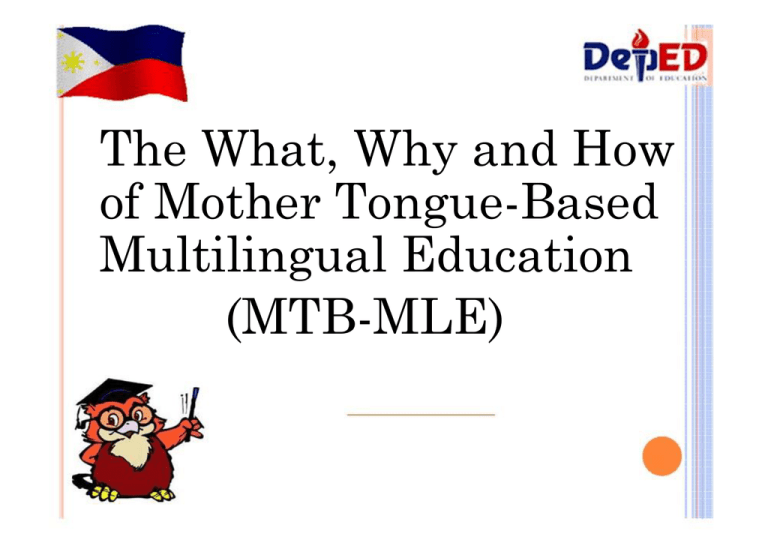
The What, Why and How
of Mother Tongue-Based
Multilingual Education
(MTB-MLE)
THE
WHAT
WHAT IS
MULTILINGUAL EDUCATION
Mother tongue-based multilingual education
(MLE) is education, formal or non - formal,
in which the learner’s mother tongue and
additional languages are used in the
classroom. Learners begin their education
in the language they understand best their mother tongue - and develop a strong
foundation in their mother language before
adding additional languages.
MULTILINGUAL
EDUCATION
|The
purpose of a multilingual
education program is to develop
appropriate cognitive and
reasoning skills enabling children
to operate equally in different
languages - starting in the
mother tongue.
MULTILINGUAL
EDUCATION
is a structured program of language
learning and cognitive development
providing
|
a strong educational foundation in the first language
successful bridging to one or more additional
languages
{ enabling the use of both/all languages for life-long
learning
{
{
is based in the child’s own known
environment and bridges to the
wider world. “Known to Unknown”
|
MULTILINGUAL
EDUCATION
|maintains
local language and culture
while providing
national/international language
acquisition and instruction
|promotes learners’ integration into
the national society without forcing
them to sacrifice their linguistic and
cultural heritage.
MULTILINGUAL
EDUCATION
|Meaning
based education enables
students to learn well because they
understand what the teacher is
saying.
|Using the culture the child knows
enables immediate comprehension
from which new concepts can be
built - going from the known to the
unknown.
MULTILINGUAL
EDUCATION
|Reading
in the mother
tongue enables immediate
comprehension
|Once we learn to read we
never have to learn again “We only learn to READ
once”
THE
WHYS
WHERE WE
ARE NOW
Insufficient mastery of basic
competencies due to congested
curriculum
High school graduates (< 18 years)
lack basic competencies and
maturity
Other countries view the 10‐year
education cycle as insufficient.
Trend in National Achievement Test (NAT) in Mean
Percentage Score for School Years 2005-2007 to 2009-2010
in Elementary and Secondary Levels
54.7
59.9
68.0
65.6
64.8
Elementary
47.0 46.7 49.3 46.7 45.6
Secondary
2005-2006
2006-2007
2007-2008
2008-2009
2009-2010
The NAT results showed low academic performance of the students in the core subjects: English,
Filipino, Mathematics, Sciences and Social Studies.
11
Grade IV Math and Science
High School Math
High School Science
1 Top
2
3
1 Top
2
3
1 Top
2
3
21
22
34
Philippines
42
24
35
36
37
23
Philippines
43
Philippines
44
45
The poor performance in the 2003 TIMSS reflects low quality of Science and Mathematics
Education in the elementary and secondary levels.
m
WHAT DO
WE KNOW
ALREADY
WE KNOW THAT…
1. The most important single
factor influencing learning
is what the learners already know.
Ascertain this and teach them
accordingly
(Ausubel, D. P. 1968. Page 235)…
WE KNOW THAT…
2. It takes children about 12
years to gain the level of
proficiency in their L1 that
will enable them to continue
developing that language for
the rest of their lives;
We know that…
3. IT TAKES CHILDREN (AND ADULTS)
AT LEAST 2 YEARS TO GAIN THE BASIC
LEVEL OF PROFICIENCY IN A NEW
LANGUAGE THAT WILL ENABLE THEM TO
USE IT FOR ‘EVERYDAY’ COMMUNICATION;
AND IF THEY DO NOT HEAR THE L2
OUTSIDE THE CLASSROOM, IT TAKES
MUCH LONGER.
WE ALSO KNOW THAT…
4. It takes them 5-7 years to develop
a level of academic proficiency in
the new language that will enable
them to use it to learn abstract
concepts, and if they don’t have
good “L1-L2-L1” teaching, they
will not ever gain
academic proficiency.
Photo:
Ari Vitikainen
And that is why we emphasize a strong
foundation - the good bridge!
BUT DEPED CAN’T DO THIS ALONE
It Takes
a Village
to Raise a
Child”
“
Vision:
Relevant and Quality
Education for All.
Desired Impact:
Learners are enjoying relevant
and quality education which
support their home languages
and cultures; Learning
outcomes are improved
country-wide; and the
Philippine is succeeding in its
goal for Education For ALL.
STATEMENT FROM PRES.
NOYNOY AQUINO…
“My
view on this is larger than
just the classroom. We should
become tri-lingual as a country;
Learn English well and
connect to the world.
Learn Filipino well and
connect to our country.
Retain your mother tongue
and connect to your
heritage."
LEGAL BASES
DepED
Order No. 74, s. 2009
“Institutionalizing Mother Tongue-Based
Multilingual Education (MTB-MLE)”
1987 Constitution (Article XIV Sec 7)
RA 8980 ECCD Law (Sec 5a)
EFA/MDG Goals
BESRA
KRT 3
Four Aspects of
Development
Language
Development
Cognitive
Development
Socio-Cultural Development
1. Language development:
Students
will establish a strong
educational foundation in the language
they know best;
will build a good “bridge” to the
school language(s), and
they
they
will be prepared to use both / all of
their languages for success in school
and for life-long learning.
2. Cognitive Development
Cognitive development begins at home at birth.
School activities will engage learners to move well
beyond the basic questions of who, what, when and
where to cover all higher order thinking skills in the
learners L1, their language of thought.
These higher order thinking skills will:
- transfer to the other languages once enough
Filipino or English has been acquired to use
these skills in thinking and articulating
thought, and
- be used in the process of acquiring English
and Filipino more effectively
3. ACADEMIC DEVELOPMENT:
Students will achieve government
competencies in each subject area
and, at the end of the program;
they
will be prepared to enter and
achieve well in the mainstream
education system.
4. SOCIAL-CULTURAL
DEVELOPMENT:
Students will be proud of their
heritage language and culture, and
respect the languages and cultures
of others;
they will be prepared to contribute
productively to their own community
and to the larger society.
THE END RESULT: CHILDREN WHO ARE …
Multilingual
Multi-literate
Multi-cultural
Same competencies but different paths
Mainstream
children who
speak the
school
language
Mainstream
children who
do NOT
speak the
school
language
L1 (school
language)
Competencies
to be achieved
by the end of
Grade 3
INITIATIVES IN MLE
A. Experiments:
a. First Iloilo Experiment (1948-1954) :
Hiligaynon as MOI in Grades 1 & II
b. Second Iloilo Language Experiment (19611964) Hiligaynon is used in first two grades
c. Rizal Experiment (1960 - 1966)
Tagalog as MOI in Grade I
d. First Language Component-Bridging
Program (FLC-BP) on “transitional”
education (1986 - 1993)
Children’s L1 in Grades I & 2 and
transition to Filipino and English
B. THE LINGUA FRANCA
EDUCATION (LFE) PILOT STUDY 1999-2002
Define and implement national bridging
program from mother tongue to Filipino
and English to develop initial literacy
y Use 4 of largest lingua francas as MOI
in grades 1 and 2:Tagalog, Hiligaynon,
Cebuano and Ilocano
y Attempt to bridge learned concept from
MT to Filipino and English
y
C. LUBUAGAN KALINGA
MLE PROGRAM
Implemented by Summer Institute of
Linguistics for 10 years
y 3 experimental classes implementing
MTB-MLE approach
y 3 control classes using traditional
method of immersion in English and
Filipino
y Schools are of same SES (Social
Economic Status)
y
RESULTS OF DIFFERENT
INITIATIVES
Children who began school in first language with
bridging to two second languages
|
were significantly more competent in all
areas of study than their counterparts
outperformed English-taught students in
reading, math and social studies
learn to read more quickly and learn better
in Math and Science
were observed to be actively participating in
different classroom activities
o Drop-out and repetition rates decreased
HE
HOWS
TAKING THE RIGHT STEPS….
National Strategic Planning for the Countrywide Implementation of Mother Tongue Based Multilingual Education (MTB-MLT)
a. Draft of Strategic Plan - November
2009 participated by 60+ educators,
advocates, NGO education
practitioners
and DepEd personnel
b. Final Strategic Plan - February 2010
|
COMPONENTS OF MTB-MLE STRATEGIC
PLAN
PreService
Teacher
Education
Social
Preparation
and
Advocacy
In-Service
Training
(INSET)
of Teachers
and School
Managers
Six
Focused
Areas
Materials
Development
Policy
Development
and Resource
Mobilization
Assessment,
Monitoring
and
Evaluation
1. SOCIAL PREPARATION AND
ADVOCACY
Local celebration of Intl Mother Language Day every Feb
21 since 2008 in partnership with 170+ Talaytayan
| Production of MLE Primer and MLE Brochure
| 1st Philippine MLE Conference held in February 2010
attended by 1000 participants
| MTB-MLE Forum, West Visayas University, Iloilo City
| Educ. Stakeholders Forum, Ateneo de Zamboanga
| Kabikolan Conference, March 2011
|
School, Division and Region based Mother Language Day
Celebration through a DepEd memo
| Other local (Region and Division) initiatives
| Translator Association of the Philippines (TAP)
| Summer Institute of Linguistics (SIL)
|
2. In-Service Training
(INSET) of Teachers and
School Managers
Figure I - Framework for MTBMLE CAPACITY DEVELOPMENT SYSTEM
PROFESSIONAL
DEVELOPMENT
Mode of Delivery
Face to Face
Web, E/
Learning
School-Based
•
•
•
Mentoring
Where are we now in terms of INSET…
|
One - Month Summer Training for 53
Teachers from Luzon and Visaya Region
UP College of Education, Diliman, QC S2010
One - Month Training for 10 Educators
Payap University, Thailand, Sept. 2010
|
|
MTB - MLE National Trainers Training (TOT) for
17 regions in 4 Phases
1. Phase I: Advocacy and Theoretical Foundations of MTB-MLE
October 2010 - DAP, Tagaytay City
100 MTB-MLE Regional Coordinators and Teachers
2. Phase II: Pedagogical Foundation MTB-MLE and Materials
Development, November 2010, Iloilo City
105 MTB-MLE Regional Coordinators and Teachers
3. Phase III: Pedagogical Foundation and Research
January, 2011, Zamboanga City
4. Phase IV: Monitoring and Evaluation
March 19 - 28, 2011 , Cebu City
|Region/Division
Initiated
Trainings: NCR, Rs-4A, 5, 6, 12
|TEI and Local Gov. Initiated
Trainings
|MTB - MLE Region - wide
Training of Teachers by National
Trainers with School Managers
- 120 teachers per region
- Summer 2011
3. MATERIALS DEVELOPMENT
|Region
initiated Write-shops (Big Books
and small books)
Bicol Region
Region VI
Region XI
Region IV - A
CARAGA Region
Region III
Region II
Region VI in partnership with TEI’s
other regions
Nation-wide initiated Write-shops on
Materials Development - Graded
Reading Big Books for 15 Languages
(8 + Yakan, Chavacano,
Maguindanaon, Manobo,
Sambal, Maranao, Tiboli
| Adapted Curriculum
| Lessons Exemplars
|
|
Primer lesson for 15 languages
4. PRE-SERVICE TEACHER
EDUCATION
|
Partnership with …..
a. Philippine Normal University, Manila
b. University of the Philippines, Manila
c. West Visayas University, Iloilo City
d. Ateneo de Zamboanga Univ., Zamboanga City
e. Western Mindanao State Univ., Zamboanga
City
f. Bicol University, Legaspi City
Summer Training for the Teacher Education
Institution (TEI) CHED Conference room,
April 4 - 15, 2011
5. POLICY DEVELOPMENT &
RESOURCE MOBILIZATION
DepEd Order 60 s. 2008 (Addendum to DepEd Order 36 s.
2006)
| Issuance of Dept of Order 74 s. 2009- “Institutionalizing
Mother Tongue Based Multilingual Education”
| MLE Country Strategic Plan
| Local Policies
MLE Resolutions:
|
y
y
y
y
y
y
y
Pangasinan Provincial Board
Region 2 -RDC
Naga City MLE resolution
Ilocos Norte provincial resolution
La Union
Cebu
In support of the Gunigundo Bill
6. ASSESSMENT,
MONITORING AND EVALUATION
|DepEd
- National Educational
Testing and Research Center
(NETRC) - Evaluation instruments
written in 8 major languages
|M & E tool being crafted by TWG
|Research on MTB-MLE being
prepared
|Language
Mapping
The
BRIDGING
Process
SEQUENCING LEARNING THROUGH LANGUAGES
Kindergarten: Building of Foundation
Build oral L1 through activities, stories, songs,
poems, rhymes, games, etc.
Introduce pre-reading activities in L1
including numeracy
Build social development and love for learning
and reading by listening and engaging in
stories read aloud.
GRADE I - FOUNDATION SETTING
Build children’s fluency and confidence in oral
L1 by using the L1 and MOI in all subjects in
activity -based lessons.
Build knowledge by using L1 as MOI in all
subjects. (Assessment in L1)
Introduce reading and writing in L1
Introduce oral Filipino focusing only on
listening and speaking activities to develop oral
competence (Assess orally)
Introduce oral English focusing only on
listening and speaking activities to develop oral
competence. (Assess orally)
GRADE II: STRENGTHENING THE FOUNDATION
Continue to build oral L1
Continue building L1 Literacy
Continue to develop oral Filipino and English for
communicative competence
Introduce Literacy in Filipino (Assess in
Filipino)
Introduce English Literacy in second semester
allowing time to develop Filipino Literacy (Assess
in English at the end of the year.)
GRADE III: BUILDING ON THE FOUNDATION
Continue to build oral L1, Filipino and English
Continue to develop literacy in L1 and Filipino
and English for Fluency and Thinking
Continue to use L1 to teach most subjects for
comprehension and thinking
Begin to use Filipino to teach Filipino domain
subjects as students are able (with scaffolding)
Begin to use English to teach English domain
subjects as students are able (with scaffolding)
in the second semester.
Continue oral development and Literacy in
L1, L2, and L3
Continue oral and written L1 & L2
Continue Oral L3
Introduce Written L3
Continue oral L1 & L2 and written L1
Introduce Literacy in L2
Introduce Oral L3
Continue oral L1
Introduce L1 literacy
Introduce Oral L2
Build
oral L1
Introducing 3
languages in
small steps”
to build
success
“
L1 - L2 - L1 TEACHING ACADEMIC
CONCEPTS
Introduce
the new concept in L1
Re-teach it in L2
Review
it in L1
Important: “Understand the concept and use the
L2 to explain and use what they have learned.
Emphasis on Meaningful Learning
Math, Science, Social Studies are concept but
also language teaching times.
Kindergarten
Grade I
Grade 2
Grade 3
Build fluency
in oral L1
MT as Subject
Build fluency in oral
L1
Introduce L1 literacy
MT as subject
MT as subject
Bridging to Filipino
Literacy
L1 pre
reading &
pre writing
Introduce
Literacy in Filipino
(L2)
Begin oral Filipino,
(Second grading)
Bridging to English
Continue building oral Literacy
English
Introduce L3 Literacy Math, Science,
Araling Panlipunan,
in the 2nd grading
Edukasyon sa
Pagpapakatao,
Math
MAPEH in L1 with
Araling Palipunan,
bridging in
Edukasyong sa
language of
Pagpapakatao,
learning
MAPEH in L1
Begin Oral English
(Second Semester
or Third Grading)
Math
Araling Panlipunan,
Edukasyon sa
Pagpapakatao,
MAPEH in L1
L1 as LOI
L1 as LOI Begin
introducing L2 & L3
Word Bank
L2-reading & writing
L3-oral
L1 as LOI
L1-L2-L1 as LOI
L1-L3-L1 as LOI
L2 - L1- L2
L3 - L2 - L3
GRADE I - Learning Areas
Learning Area
Edukasyon sa
Pagpapakatao
Math
Time Allotment
Medium of
Instruction
40
Mother tongue
40
MT
Araling Panlipunan 30
MT
MAPEH
30
MT
Mother Tongue
40
English
30
(oral fluency)
Filipino
30
(oral fluency)
CLASS MODELS
CLASS MODELS
Situation
1.
One School - One
Class One Language
2. One School - Two
Classess - Two
Languages
3. One School Several Classess Several Languages
Class Model
1. Basic Monolingual
2. Basic Monolingual
(group students according to
language & match it with the
teacher)
3. Modified Monolingual
a.
Group the class according to
Laguage & match it with the
teacher
a.1 One class can be monolingual
a.2 One or two classes can be bior tri- lingual (assistance
from the parents who are
native speakers is necessary)
CLASS MODELS
4. One School- Multiple
Languages - Multiple
Classess
|
Lingua Franca (use of
the community
language)
MTBMLE BRIDGING PLAN IN A 3 YEAR PROGRAM
FIRST LANGUAGE AS L1, FILIPINO AS L2, ENGLISH AS L3
Grade
III
L1
Math
Grade
II
L1
Grade I
K
Sci
MAPEH
Edukasy Araling
Fil
on sa
Panlipun
Pagpapa an
katao
Eng
Math
MAPEH
Edukasy Araling
Fil
on sa
Panlipun LSRW
Pagpapa an
katao
Oral then
RW Eng
L1 - L, S, Math
R, W, V
MAPEH
Edukasy Araling
Oral
on sa
Panlipun Fil
Pagpapa an
katao
Oral
Eng
Mother Tongue - language, math, values etc.
MTBMLE BRIDGING PLAN IN A 3 YEAR PROGRAM
L1 AS FILIPINO, L2 AS ENGLISH, ANOTHER L3
Grade
III
L1 Fil
Math
Grade
II
L1 Fil
Grade I
K
Sci
MAPEH
Edukasy Araling
L3 LSRW Eng
on sa
Panlipun
Pagpapa an
katao
Math
MAPEH
Edukasy Araling
Oral
on sa
Panlipun L3
Pagpapa an
katao
Oral then
RW Eng
L1 - L, S, Math
R, W, V
MAPEH
Edukasy Araling
Oral
on sa
Panlipun L3
Pagpapa an
katao
Oral
Eng
Mother Tongue - language, math, values etc.
MTBMLE BRIDGING PLAN IN A 3 YEAR PROGRAM
L1 AS ENGLISH, L2 AS FILIPINO, ANOTHER L3
Grade III
L1 Eng Math
Grade II
Grade I
K
Sci
MAPEH
Edukasy Araling
Fil LSRW Oral then
on sa
Panlipun
RW L3
Pagpapa an
katao
L1 Eng Math
MAPEH
Edukasy Araling
Oral
on sa
Panlipun Fil
Pagpapa an
katao
Oral L3
L1 - L, S, Math
R, W, V
MAPEH
Edukasy Araling
Oral
on sa
Panlipun Fil
Pagpapa an
katao
Oral L3
Mother Tongue - language, math, values etc.
MTBMLE Bridging Plan in a 3 year program
L1 First Language, L2 Filipino, L3 English, L4 Arabic
Grade III
L1
Math
Grade II
L1
Math
Grade I
K
L1 - L, S, Math
R, W, V
Sci
MAPEH Eduka L2
syon
sa
Pagpa
pakata
o
Araling L4
Panlipun
an
Eng
MAPEH Eduka L2 LSRW Araling
syon
Panlipun L4
sa
an
Pagpa
pakata
o
Oral then
RW
Eng
MAPEH Eduka Oral L2
syon
sa
Pagpa
pakata
o
Oral
Eng
Araling L4
Panlipun
an
Mother Tongue - language, math, values, socio-cultural processes etc.
